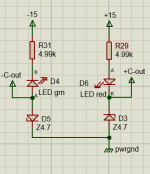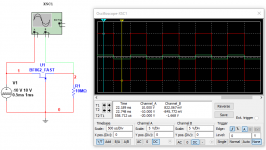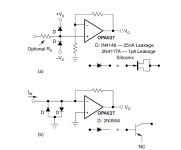I am using a scarlett 2i2 for thd measurement and can get 0.0005% distortion levels.
How do I add input protection without degrading this performance?
I tried using pair basic green LEDs as described by akitika and I think also documented in the ARTA manual.
https://www.akitika.com/documents/BuildingTheAttenuatorRev4.pdf
Distortion gets worse.
What is a good input protection circuit to use?
Where are good examples to copy from
How important is diode leakage and selecting the right parts?
Thank you
How do I add input protection without degrading this performance?
I tried using pair basic green LEDs as described by akitika and I think also documented in the ARTA manual.
https://www.akitika.com/documents/BuildingTheAttenuatorRev4.pdf
Distortion gets worse.
What is a good input protection circuit to use?
Where are good examples to copy from
How important is diode leakage and selecting the right parts?
Thank you
What worked well for my autoranger is a pair of very low leakage diodes biased to the protection level you want. The best diodes I found are the FDH300's but JFETs like the LSJ4441 (I think), S and D connected, are also very low leakage.
See example circuit.
Jan
See example circuit.
Jan
Attachments
Last edited:
What worked well for my autoranger is a pair of very low leakage diodes biased to the protection level you want. The best diodes I found are the FDH300's but JFETs like the LSJ4441 (I think), S and D connected, are also very low leakage.
See example circuit.
Jan
Audio Precision uses that approach. uses the FET tied as diodes. Adds no distortion. I over-voltage an input with DC (didnt change to AC-coupled) and no damage... just replaced the FETs and all worked fine again.
THx-RNMarsh
Last edited:
I am using a scarlett 2i2 for thd measurement and can get 0.0005% distortion levels.
How do I add input protection without degrading this performance?
I tried using pair basic green LEDs as described by akitika and I think also documented in the ARTA manual.
https://www.akitika.com/documents/BuildingTheAttenuatorRev4.pdf
Distortion gets worse.
What is a good input protection circuit to use?
Where are good examples to copy from
How important is diode leakage and selecting the right parts?
Thank you
Blue, violet or white LEDs have the highest bandgap, so largest distortion-free range. Some green LEDs are high bandgap (GaN), some aren't...
However non-linear capacitance can be an issue too, and this kicks in before the diode starts to conduct. Low impedance levels help here.
1N4148's as clamps to two voltage rails is another possibility, they are pretty low capacitance (probably better than random LEDs).
There's a reasonable amount of protection in just using series resistanceto limit current - the unit will probably have some sort of voltage clamping internally, limiting the current will help that out.
I use clamping diodes BAV21 to rails +-3V (short time period) until SSR disconnects the amplifier output (scaled down by resistor divider). The SSR driver has lower threshold than clamping.
look here:
Power amp measurement system
Power amp measurement system
I'am about to design an extension box with true-rms meters to display the input and output voltages.
look here:
Power amp measurement system
Power amp measurement system
I'am about to design an extension box with true-rms meters to display the input and output voltages.
Last edited:
Such a way has some drawbacks.I just use a 10:1 or 100:1 scope probe. Effectively no distortion added.
That won't work for ultra-low distortion measurements because of high probe resistance and so high noise (and EMI-noises, 50/60 Hz too). And some soundcards have a quite low input impedance, even up to several kOhms, so divider won't be accurate 10:1.
Vovk, the 2i2 appears to have a 1.5Meg instrument input, so as long as the probe can be compensated for a flat response then it would happily do the job of providing high voltage measurement capability (ie. protection from most voltages found in an amp circuit), as measurement level accuracy has to be relative to an external meter for starters due to the 2i2 gain pots.
The 2i2 is not an 'ultra-low distortion' device for starters, and noise ingress from the probe is entirely related to the measurement environment, where a little care with shielding and probing would happily push noise below the 2i2 noise floor.
The 2i2 is not an 'ultra-low distortion' device for starters, and noise ingress from the probe is entirely related to the measurement environment, where a little care with shielding and probing would happily push noise below the 2i2 noise floor.
I was aware that 1N4148 clamp diodes could be modulated by fluorescent light, but re-reading a datasheet I now note that ambient or other light falling on a 1N4148 (i.e. glass body diode) would increase the input bias current of a low noise JFET opamp by several orders of magnitude. (OPA627/637 ds). From the datasheet:
Attachments
What worked well for my autoranger is a pair of very low leakage diodes biased to the protection level you want. The best diodes I found are the FDH300's but JFETs like the LSJ4441 (I think), S and D connected, are also very low leakage.
See example circuit.
Jan
LinearSystems Low Leakage Diodes:
DMOS Switches, JFET Amplifiers, BIFET Amplifiers, MOSFETS
- Status
- This old topic is closed. If you want to reopen this topic, contact a moderator using the "Report Post" button.
- Home
- Design & Build
- Equipment & Tools
- Low noise input protection for sound card



